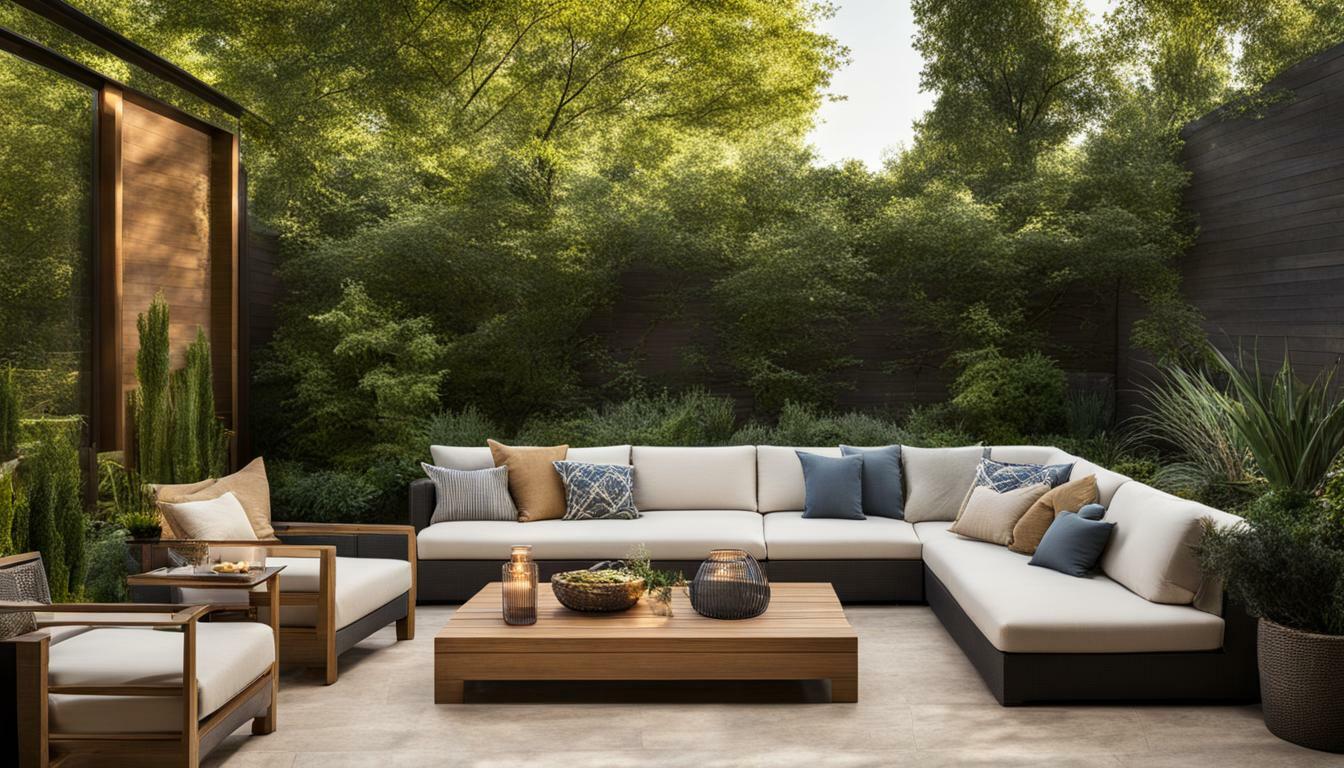What Are the Best Eco-Friendly Patio Cover Materials?

When it comes to creating an outdoor space that is both beautiful and sustainable, choosing the right patio cover material is key. With so many options available on the market, it can be challenging to know which ones are truly eco-friendly and can enhance your outdoor space while reducing your environmental impact.
In this article, we will explore the top eco-friendly materials available for patio covers. We will discuss the sustainability, benefits, and features of each material and offer insights on how to choose the perfect one for your specific needs. From recycled materials to natural fibers and living patio covers, you’ll learn everything you need to know about creating a green patio solution.
Key Takeaways
- Eco-friendly patio cover materials are sustainable options that reduce environmental impact.
- Choosing the right material involves considering durability, weather resistance, maintenance requirements, and design compatibility.
- Options include natural fibers, recycled materials, living patio covers, and more.
- Proper installation and maintenance are essential to keep eco-friendly patio covers in excellent condition.
- Selecting an eco-friendly patio cover material can help create a beautiful outdoor space while minimizing environmental impact.
Benefits of Using Eco-Friendly Patio Cover Materials
When it comes to choosing patio cover materials, there are numerous eco-friendly options that offer a range of benefits for your outdoor space and the environment. By selecting sustainable cover options, you can reduce your carbon footprint, conserve resources, and create a beautiful and functional patio area.
Energy Efficiency
Eco-friendly patio covers can enhance energy efficiency by providing shade and reducing heat gain in the summer months. This can help lower your energy bills and reduce your reliance on air conditioning.
Sustainability
Many eco-friendly patio covers are made from sustainable materials such as bamboo, reclaimed wood, or recycled plastic. By choosing these options, you can help reduce deforestation and the amount of waste that ends up in landfills.
Design Flexibility
Eco-friendly patio covers come in a variety of styles, colors, and materials, giving you the freedom to create a unique outdoor space that suits your needs and preferences. From metal and polycarbonate to fabric and living covers, the options are endless.
Low Maintenance
Eco-friendly patio covers often require less maintenance than traditional covers made from materials such as vinyl or aluminum. For example, some natural fiber covers only require occasional cleaning and can last for years without needing to be replaced.
Environmental Benefits
By using eco-friendly patio cover materials, you can help reduce your environmental impact by conserving resources, reducing waste, and minimizing the use of harmful chemicals. This can contribute to a healthier planet and a better future for generations to come.
Cost Savings
While some eco-friendly patio cover materials may have a higher upfront cost, they can provide long-term cost savings by reducing energy bills, minimizing maintenance needs, and lasting longer than traditional covers.
When choosing eco-friendly patio cover materials, consider your specific needs and preferences, as well as factors such as durability, maintenance requirements, weather resistance, and design compatibility. By selecting the right cover for your space, you can create an outdoor area that is not only beautiful and functional but also environmentally conscious.
Wood Patio Covers: A Sustainable Choice
When it comes to eco-friendly patio covers, wood can be a great option. However, not all wood is sustainable, so it’s important to do your research when choosing wood for your patio cover.
Sustainable Wood Choices [Eco-Friendly Patio]
Look for wood that is certified by the Forest Stewardship Council (FSC). This means that the wood comes from responsibly managed forests and is harvested in a way that minimizes environmental impact. Some popular sustainable wood choices for patio covers include:
- Cedar
- Redwood
- Bamboo
Treatment Methods
It’s important to consider the treatment method used on your wood patio cover. Chemical treatments can have negative environmental impacts, so look for wood that has been treated with natural or non-toxic products.
Natural, Inviting Atmosphere
Wood patio covers can create a natural, inviting atmosphere in your outdoor space. The warm tones of the wood can complement various design styles, from rustic to modern. Plus, wood is a renewable resource, making it a sustainable choice for your patio cover.
Recycled Materials: Repurposing for Patio Covers
If you’re looking for an environmentally conscious way to create a unique and stylish patio cover, consider using recycled materials. By repurposing discarded items, you not only reduce waste but also add a distinctive touch to your outdoor space. Here are some sustainable cover options to consider:
Reclaimed Wood
Using reclaimed wood for your patio cover is an excellent way to give new life to old materials. Salvaged wood from old structures, shipping pallets, or even fallen trees can provide an attractive and durable solution for your patio. Keep in mind that while this material may be eco-friendly, it may require more upkeep than other options.
Plastic Alternatives
Plastic is one of the most common materials we use in our daily lives, and it’s also one of the most wasteful. By using recycled plastic, you can help keep this material out of landfills and oceans while creating an attractive patio cover. Plastic lumber, made from recycled drink bottles and other plastic waste, can be an excellent alternative to traditional wood.
Metallic Options
Metal is another material that is often discarded without much thought. However, with a bit of creativity, recycled metal can be repurposed into an attractive and sustainable patio cover. Old corrugated metal roofing or discarded industrial metal can add an industrial chic touch to your outdoor space.
Glass and Mirrors
Using reclaimed glass and mirrors is a unique way to create an eye-catching patio cover. Salvaged or repurposed glass can be upcycled into beautiful mosaic patterns, while mirrors can reflect light and create an illusion of more space in your outdoor area.
When considering recycled materials for your patio cover, keep in mind that while repurposed items can be eco-friendly, they may not always be the most practical or long-lasting option. Consider factors such as durability, weather resistance, and maintenance requirements before making a final decision.
Natural Fiber Patio Covers: Creating an Organic Oasis
When it comes to eco-friendly patio cover materials, natural fibers such as bamboo, rattan, and hemp are gaining popularity. These materials not only offer sustainability but also create a serene and organic atmosphere in your outdoor space.
One major benefit of natural fiber patio covers is their durability. These materials are known for their strength and resilience, making them ideal for outdoor use. Additionally, they require little maintenance and are resistant to rot, decay, and insect damage.
Another advantage of using natural fibers is their aesthetic appeal. Bamboo and rattan offer a unique texture and natural color that can complement a variety of design styles, while hemp has a more rustic and earthy appearance.
Furthermore, natural fiber patio covers are sustainable because they are renewable resources that grow quickly and require minimal resources to produce. They are also biodegradable, making them a responsible choice for the environment.
When considering natural fiber patio covers, it’s important to note that they may not provide as much shade as other materials, and they may require additional support to accommodate windy conditions. However, their beauty and sustainability make them an excellent option for creating an organic oasis in your outdoor space.
Metal Patio Covers: Stylish and Sustainable
When looking for eco-friendly patio cover materials, metal may not be the first option that comes to mind. However, metal covers can be both stylish and sustainable, making them an attractive choice for those seeking a modern and durable outdoor design.
Metal patio covers can be made of various materials, including aluminum and steel. These materials are highly durable, meaning they can withstand the elements and resist rust and corrosion. This makes them suitable for areas with high moisture or extreme weather conditions.
In addition to their durability, metal patio covers require low maintenance. Unlike wood covers, they do not need regular staining or painting, which can save you time and money in the long run.
Metal covers also have a contemporary aesthetic that can complement various outdoor design styles. They can be customized to fit your specific patio dimensions and come in a range of colors, from sleek silver to bold shades.
Aluminum Patio Covers
Aluminum is a popular choice for patio covers due to its lightweight, yet sturdy characteristics. It is also highly recyclable, making it a sustainable option for those concerned with minimizing environmental impact.
Aluminum covers can come in a variety of styles, including solid or louvered panels, and can be painted to match your home’s exterior. They provide shade and protection from the elements while allowing for natural light and airflow.
Steel Patio Covers
Steel is a durable and long-lasting material that can withstand severe weather conditions, making it an excellent choice for patio covers. However, it is important to note that steel is not as lightweight as aluminum and may require additional support for installation.
Steel covers can be powder-coated in a range of colors and designs to complement your outdoor space’s aesthetic. They offer a sleek and modern look while providing shade and protection from the sun and rain.
When choosing metal patio covers, it is important to consider the material’s thickness, as thicker materials can provide better durability and support. You should also ensure that the covers are properly installed and maintained to prevent rust or corrosion.
Overall, metal patio covers offer a stylish and sustainable option for those looking to enhance their outdoor space while minimizing their environmental impact. Consider using metal covers for a contemporary and low-maintenance design that can provide protection and beauty for years to come.
Polycarbonate Patio Covers: Energy-Efficient Transparency
When considering eco-friendly patio cover materials, polycarbonate may not immediately come to mind. However, this durable thermoplastic material has a range of benefits that make it a popular choice for environmentally conscious homeowners.
Polycarbonate patio covers are highly transparent, allowing natural light to filter through while protecting your outdoor space from the elements. This energy-efficient quality can help reduce your reliance on artificial lighting and lower your electricity bills.
Additionally, polycarbonate is impact resistant, making it a sturdy option for areas prone to heavy winds, hail, or debris. Its ability to withstand extreme temperatures also makes it an ideal choice for areas with unpredictable weather patterns.
Poly-carbonate patio covers are also lightweight and easy to install, which can save you time and money on installation costs.
Polycarbonate Patio Covers: Sustainable Features
Poly carbonate patio covers can be made from recycled materials, which can reduce waste and resource consumption. Additionally, polycarbonate covers can be easily recycled at the end of their lifespan, reducing their impact on the environment.
Furthermore, polycarbonate patio covers can contribute to energy savings in your home. Their ability to filter natural light can reduce the need for artificial lighting, while their insulation properties can help regulate indoor temperatures, reducing the need for heating and cooling.
In summary, polycarbonate patio covers are a stylish and energy-efficient option for those seeking an eco-friendly cover material. Its transparency and durability make it an ideal choice for various outdoor spaces, while its sustainable features contribute to a healthier planet.
Fabric Patio Covers: Versatile and Eco-Friendly
Fabric patio covers offer a sustainable alternative to traditional solid covers. These covers can be made using a variety of eco-friendly materials such as recycled polyester, natural fibers like cotton or hemp, or even bamboo. These materials provide both durability and a unique aesthetic appeal to your outdoor space.
One of the main benefits of fabric patio covers is their versatility. They come in various shapes, sizes, and designs, allowing you to customize your cover to your specific needs. Shade sails, for example, offer a modern look and can be configured in multiple configurations to suit your patio’s design. Retractable awnings provide flexible shading options that can be adjusted to your preferences based on the weather.
But beyond their visual and functional appeal, fabric patio covers are also eco-friendly. They typically have a smaller environmental impact than solid covers because they allow for natural ventilation and light to pass through. This can help reduce energy costs by decreasing the need for artificial lighting and cooling. Additionally, many fabric covers are made from sustainable materials making them a green patio solution for the environmentally conscious.
When choosing a fabric patio cover, it is important to consider the material’s durability, weather resistance, and compatibility with your patio’s design. Some materials may require more maintenance than others, so it is essential to ensure it suits your maintenance needs. With proper care and maintenance, however, fabric patio covers can last for years, making them a cost-effective and sustainable choice.
Living Patio Covers: Embracing Nature
Imagine stepping outside to your patio and being greeted by lush greenery, blooming flowers, and the sound of birds singing. With living patio covers, this dream can become a reality. These innovative eco-friendly options allow you to embrace nature while enhancing the beauty of your outdoor space.
One popular living patio cover option is a green roof. This involves covering your patio with soil and vegetation, creating a layered living ecosystem on your roof. Green roofs offer numerous benefits, including reducing energy costs, improving air quality, and mitigating storm water runoff.
Vine-covered pergolas are another living patio cover option that can provide shade and beauty while benefiting the environment. With vines such as wisteria, grape, or climbing roses, you can create a natural canopy over your patio, inviting birds and beneficial insects to your outdoor space.
When considering a living patio cover, it’s essential to choose plants that are compatible with your climate and sunlight conditions. Consult with a local gardening expert to ensure that you select the right plants for your area. You’ll also need to ensure that your patio can support the weight of the soil and vegetation.
Living patio covers require regular maintenance, including watering, fertilizing, and pruning. However, the benefits of these innovative options far outweigh the upkeep required. By embracing nature and utilizing living patio covers, you can create a stunning outdoor space while promoting sustainability and environmental consciousness.
Choosing the Right Eco-Friendly Patio Cover Material for Your Space
When deciding on the ideal eco-friendly patio cover material for your outdoor space, there are several factors to consider. First and foremost, sustainability should be a top priority. Look for materials that have minimal environmental impact and are renewable or recyclable.
Durability is also crucial, especially if you live in an area with extreme weather conditions. Select materials that can withstand rain, snow, wind, and sun exposure without deteriorating quickly or requiring frequent repairs.
Another essential consideration is maintenance. Some materials may require more upkeep than others, so choose a material that aligns with the level of maintenance you are willing and able to provide.
Finally, aesthetic appeal and design compatibility play a role in selecting the right eco-friendly patio cover material. Consider the color, texture, and style of the material to ensure it complements your outdoor space’s overall design scheme.
Factors to Consider When Choosing Eco-Friendly Patio Cover Materials
| Factor | Considerations |
|---|---|
| Sustainability | Choose materials with minimal environmental impact; look for renewable or recyclable options. |
| Durability | Select materials that can withstand harsh weather conditions without deteriorating quickly or requiring frequent repairs. |
| Maintenance | Consider the level of maintenance required for each material and choose one that aligns with your preferences and abilities. |
| Aesthetic Appeal | Take into account the color, texture, and style of the material to ensure it complements your outdoor space’s overall design scheme. |
Overall, choosing an eco-friendly patio cover material that fits your needs and preferences can enhance both the beauty and sustainability of your outdoor space. Consider all factors carefully to make an informed decision and enjoy your eco-friendly patio covers for years to come.
Installing and Maintaining Eco-Friendly Patio Covers
Installing and maintaining eco-friendly patio covers is important to ensure their longevity and effectiveness in protecting your outdoor space. Here are some practical tips to help you get started:
Proper Installation Techniques
Make sure to follow the manufacturer’s instructions carefully when installing your eco-friendly patio cover. Improper installation can result in damage to the cover or your outdoor space. If you are unsure about the installation process, consider hiring a professional installer to ensure a secure and safe installation.
Cleaning Methods
Regular cleaning is essential to keep your patio cover looking its best and to prevent the growth of mold or mildew. Be sure to use eco-friendly cleaning products that are safe for the environment and won’t harm your cover. Avoid using harsh chemicals or pressure washers, as this can damage the cover’s material.
Regular Maintenance
Regular maintenance is necessary to keep your patio cover in top condition. Depending on the material you choose, you may need to repaint or reseal the cover periodically. Make sure to inspect your eco-friendly patio cover regularly for signs of wear and tear, and address any issues promptly to prevent further damage.
Consider Your Climate
When selecting an eco-friendly patio cover material, consider the climate in your area. For example, if you live in an area with heavy rainfall, you may want to choose a material that is resistant to water damage.
Choose a Compatible Design
Make sure to choose an eco-friendly patio cover material that complements your outdoor design style. Whether you prefer a natural and organic look or a sleek and modern aesthetic, there are many sustainable materials to choose from that will enhance the beauty of your outdoor space.
Regular Inspections
Regularly inspecting your eco-friendly patio cover can catch any damage or repairs that need to be made. Regular maintenance and inspections will prolong the life of your patio cover and save you money in the long run.
Conclusion
In conclusion, choosing eco-friendly materials for your patio covers can benefit both your outdoor space and the environment. By selecting sustainable options, you can reduce your environmental impact while creating a beautiful and functional outdoor oasis.
Consider important factors such as durability, maintenance requirements, weather resistance, and design compatibility when selecting the ideal eco-friendly patio cover material for your specific needs. Whether you choose wood, recycled materials, natural fibers, metal, polycarbonate, fabric, or living covers, each option offers unique benefits and a range of aesthetic choices.
Proper installation techniques, cleaning methods, and regular maintenance routines are also essential to ensure that your patio covers remain in excellent condition for years to come. By following these best practices, you can maximize the lifespan and eco-friendliness of your patio covers.
In summary, incorporating eco-friendly materials into your patio cover design is a smart and sustainable choice that can help protect the planet and enhance your outdoor space. From reducing environmental impact to enhancing energy efficiency, these materials offer numerous advantages for both you and the environment. So, go ahead and explore the world of eco covers and create a green patio solution that complements your lifestyle and values.
FAQ
What are the best eco-friendly patio cover materials?
The top eco-friendly materials for patio covers include wood, recycled materials, natural fibers, metal, polycarbonate, fabric, and living covers.
What are the benefits of using eco-friendly patio cover materials?
Using eco-friendly patio cover materials reduces environmental impact, enhances energy efficiency, and contributes to a sustainable outdoor space.
Why is wood a sustainable choice for patio covers?
Wood patio covers are sustainable because of their renewable nature, and they create a natural and inviting atmosphere in outdoor areas.
How can recycled materials be repurposed for patio covers?
Recycled materials such as reclaimed wood, plastic, and metal alternatives can be creatively repurposed to create sustainable and unique patio covers.
What are natural fiber patio covers and why are they eco-friendly?
Natural fiber patio covers, such as bamboo, rattan, and hemp, are eco-friendly due to their durability, aesthetic appeal, and contribution to creating an organic outdoor oasis.
Why are metal patio covers considered both stylish and sustainable?
Metal patio covers, including aluminum and steel options, offer durability, low maintenance, and a contemporary aesthetic that complements various outdoor design styles.
What are the benefits of using polycarbonate materials for patio covers?
Polycarbonate patio covers provide high transparency, impact resistance, and energy efficiency, adding a unique touch to outdoor spaces.
How versatile are fabric patio covers and how do they contribute to eco-friendliness?
Fabric patio covers, such as shade sails and retractable awnings, are versatile and eco-friendly, providing protection from the elements while allowing airflow and natural light.
What are living patio covers and how do they embrace nature?
Living patio covers, such as green roofs and vine-covered pergolas, not only provide shade and beauty but also contribute to a healthier environment by incorporating nature into outdoor spaces.
How can I choose the right eco-friendly patio cover material for my space?
When selecting an eco-friendly patio cover material, consider factors such as durability, maintenance requirements, weather resistance, and design compatibility to make an informed decision.
What are some tips for installing and maintaining eco-friendly patio covers?
Proper installation techniques, regular cleaning methods, and maintenance routines are important for ensuring that eco-friendly patio covers remain in excellent condition for years to come.
- Crafting a Dream Patio with Pavers - November 26, 2023
- DIY Patio Paver Construction - November 24, 2023
- Creating Stunning Patios with Pavers - November 21, 2023


